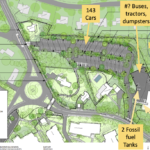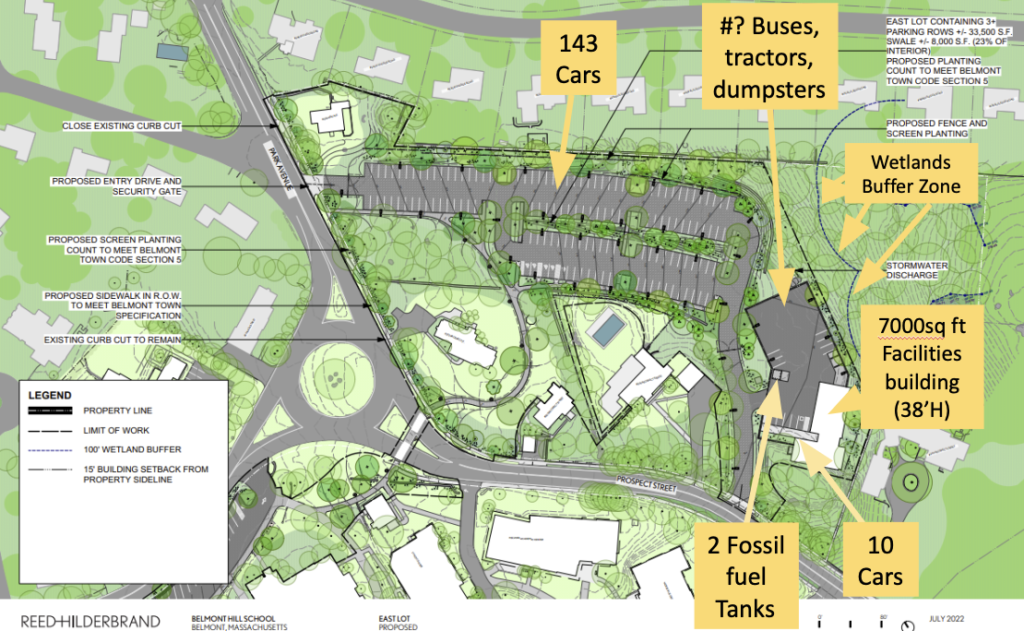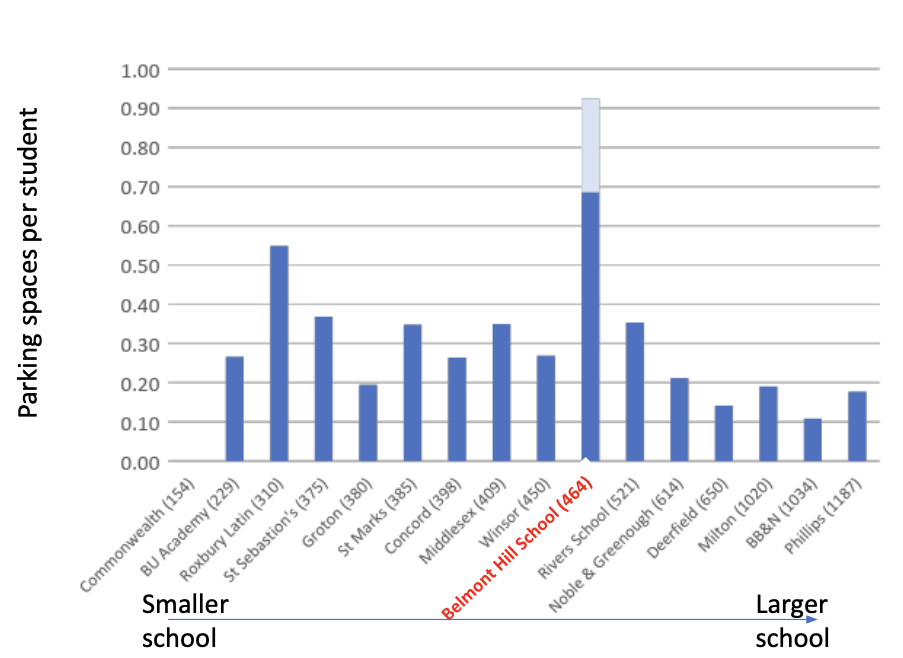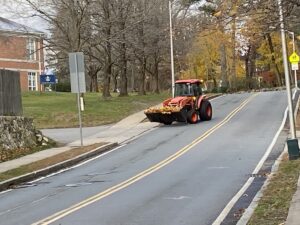
By Justin Roe
Belmont Hill School submitted their long-awaited plan for the Belmont Hill woodlands area to the planning board in October. The response from Belmont’s residents was instantaneous and overwhelming in opposing the proposal.
Within three weeks, Belmont’s Select Committee and Planning Board have received hundreds of letters voicing town opposition to the project. A petition in opposition has attracted over 2,200 signatures, and hundreds of lawn signs and banners are popping up in every district in Belmont. School action groups from Lexington and Waltham are taking an active role. All within a few weeks.
The school presented its plan to the Belmont Planning Board on November 15. The full proposal was posted on the town website at bit.ly/BCF-BHS-application: images from the plans are available at bit.ly/BCF-BHS-Drawings. The school plans to raze a significant portion of the seven-acre woodland on Belmont Hill, leaving only 28 trees and creating a 153-car parking lot, a 7,000 sq. ft. building, two large above-ground fossil-fuel tanks, and an area for buses, tractors, and dumpsters.

Figure 7 from page 59 of the Belmont Hill School’s August application to develop seven acres of woodlands with the author’s annotations. Graphic: Justin Roe
No residential or commercial enterprise would be allowed to implement such a plan. It contravenes Belmont’s sustainability objectives and the Single Family Zoning. The school is claiming its planned use is “educational,” which gives it the right to perform this construction under the state’s Dover Amendment. However, for the Dover Amendment to apply, the educationally significant goal must be the “primary or dominant” purpose for which the land or structures will be used.
The school also has an obligation to show a reasonable need. Belmont Hill is claiming that additional parking, facilities building, and depot and fossil-fuel tanks are essential to properly fulfill their educational mission, even though the school is not increasing enrollment. Let’s look at each of the school’s claimed needs.
Parking
According to the proposal, Belmont Hill School currently has 318 parking spaces (268 on campus and 50 on the opposite side of Route 2 in Arlington). It has 464 students from 5th to 12th grade and 153 faculty and staff. The proposal states that “there is not adequate student parking under existing conditions,” yet when pressed by the planning board on November 15, the school admitted that currently, if all eligible students and all faculty/staff need to park at the same time on the same day, they would be 29 spaces short in their on-campus lot and would have to resort to using their 50-space satellite parking on the other side of Route 2, a 13-minute walk away.
It turns out that Belmont Hill School’s parking-space-to-student ratio is already by far the highest among its peers, yet they claim to need an additional 153-car parking lot, roughly equivalent in size to Belmont’s Star Market parking lot.
Facilities yard and maintenance building
The second element of the proposal is the location of a maintenance building and facilities yard in the area zoned for single-family homes. It towers a staggering 38 feet tall with an 11-foot concrete wall at its highest point. The facilities building will service the campus and playing fields, yet the maintenance building is located on the opposite side of Prospect Street. We already see unregistered Belmont Hill School vehicles, maintenance machinery, and golf carts traveling on Belmont roads and sidewalks. Does it make sense to have these unregistered vehicles constantly crossing a busy street?
The facilities yard will contain dumpsters, trash, buses, trailers, boats, maintenance vehicles, salt, and sand, all about 10 feet from the wetlands buffer zone. There is a designated “snow removal gate” specifically to push all this snow, salt, spilled fuel, and pollution off the end of the yard and into the very steeply graded area that supplies the wetlands. “Snow storage for the Facilities Yard is the vegetated area located north of the paved yard,” according to the application.
Fossil-fuel tanks
The plan’s third major element is two fossil-fuel tanks. Belmont has taken sustainability very seriously. Boston Magazine puts Belmont in the Top 10 greenest towns in Massachusetts and the Mass Climate Network at #2 because of its energy-sustainability programs. However, by proposing fossil-fuel tanks, the school seems remarkably tone deaf to Belmont residents’ sustainability and safety efforts.
Belmont residents have been vocal about demanding that the Belmont Department of Public Works (DPW) put its fuel tanks below ground when within 300 feet of neighboring properties, which the DPW agreed to do.
Belmont Hill is seeking to place above-ground fuel tanks approximately 130 feet from the nearest neighbor, well short of the minimum safety recommendation of 300 feet. The school has never in its history had fossil-fuel tanks, but it feels that now is the right time to introduce them.
Climate change
This proposal would entirely clear-cut the woodland and wildlife refuge. The land would be regraded with many tons of landfill, with possible ledge blasting. The proposal has a weak plan to replace the enormous loss of mature canopy with saplings and bushes. The Belmont Hill trees would be replaced with an out-of-proportion and unnecessary parking lot, fossil-fuel tanks, a maintenance depot, and a facilities yard. For more information about the health and environmental benefits of trees, see “Urban Trees Improve Everyones’ Lives,” BCF Newsletter, November 2021.
So how can Belmont Hill School claim that this development is educational? First, don’t be fooled by the fact they call it “East Campus”. There is not one single educational element of this plan. Calling it educational is a brazen claim to move everything dirty, smelly, environmentally damaging, and noisy off their pristine campus and dump it onto a new plot of land away from their campus, and among local residents.
Belmont Hill School claims to be surprised and upset by the town’s reaction to their proposal. Could they not have predicted that this would be very unpopular in a town with one of the state’s best sustainability records? Or is the truth that they hoped to get this proposal through and begin clear-cutting before anyone took notice?
The school seems to have forgotten its obligation as a responsible neighbor in our community. There are many other ways to achieve what they want, like reducing parking spaces, interspersing the car spaces among the existing trees and retiring fossil-fuel vehicles and land maintenance tools. It may cost slightly more, but with a $100 million-plus endowment and some very wealthy donors, a much better solution can be found.
It’s time to rethink the whole project. It’s the school’s obligation to the town and to the next generation that they are teaching.
Learn more
Attend a Planning Board meeting, usually held on Tuesdays at 7 pm. Access is by Zoom only, and the link and meeting schedules are posted at www.belmont-ma.gov/planning-board. You will have an opportunity to comment at the meeting, but just attending keeps you informed and sends a message of concern and scrutiny to the planning board and the school.
Upcoming Planning Board meetings
January 17: Environmental and stormwater concerns
February 7: Peer review feedback; close public hearing and begin deliberations
February 21: Continued deliberations up to and approval of a final decision
Visit www.belmontwild.org for more information about the project. You can find the petition opposing the project at www.belmontwild.org/signing.
Justin Roe is a 26-year Belmont resident.




Sorry, the comment form is closed at this time.